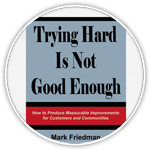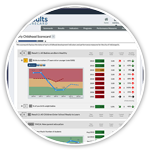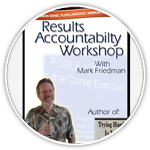The Mismatch Between State, County and Neighborhood Agendas for Children and Families
It used to be that “We’re from the government and here to help you.” was one of the three great lies. Now we risk furthering cynicism about state local cooperation by repeating past mistakes under the rubric of partnership. Much progress has been made in advancing the notions that work on the well-being of children, families and communities should be driven by the results we want. And there is a genuine and growing recognition that any chance we have of creating better results for children depends on working across systems and across levels of government. The term partnership has come to capture this last change for the better. And yet, partner how, with whom, and for what are central questions. We have talked in other forums about “how.” It’s a negotiation process, not a top down RFP process. And we have talked about “with whom.” The need for “governance” entities which bridge categorical boundaries and are “accountable” for the well being of the whole child and the whole family. But the “about what” part is not getting as much attention. And it may turn out to be the most important.
In state and local partnerships “the what” should be about improving conditions of well-being for children and families. It should be grounded in results and indicator statements which capture what is most important about child and family well-being and let us know if things are getting better or worse. And it should force us to move from talking about these conditions to doing something about them; focus the discussion on turning the curve, actions which measurably improve well-being. But what to work on?
There is a growing and largely untalked about mismatch between what communities want to work on (and are working on) and what states want to work on. (Counties and cities usually find themselves somewhere in the middle.) And unless we come to terms with this phenomenon, it threatens to set back a lot of good work. In a nutshell, states want help with some of the big problems they face. They need to implement welfare reform and reduce welfare caseloads; they need to implement managed care for Medicaid recipients for both physical and mental health; and they need to bring the growth of foster care and juvenile justice caseloads under control. All of these are big dollar issues, where states realize that harnessing community energy and assets can make a big difference. And there is growing evidence to support this view. (A number of communities have in fact taken on these challenges: Welfare: Cleveland Works and Community Econ Dev; Managed Care: Local initiatives for child mental health – see Cincinnati and Milwaukee; Foster Care: see Los Angeles networks and Clark Foundation Initiative)
Yet, when neighborhood people speak for themselves, two things often become clear. First, they are not interested in taking on the world. Often it’s the same volunteers coming forward again. People’s time commitments are already pretty stretched, and anything new better be “worth it.” And second, neighborhood people don’t want to take over state responsibilities. They don’t have the time, energy, interest or expertise to run the welfare system, oversee child abuse investigations, or implement managed care. Most often what they want to take on are matters like crime (juvenile crime and drug abuse), economic development and jobs, school quality, recreation, and physical quality of life issues.
We have helped foster a movement toward local “governance” entities which are intended to oversee the well-being of children and families across systems and across communities. And yet we threaten to derail this work by insisting that neighborhood level governance entities work on what the state wants them to work on.
How about a different approach? How about working together to create a common set of results and indicators that tell us how children at the state, county, city and neighborhood levels are doing. And then let communities decide what they want to work on. States will almost always have an important stake in the choices they make. (Lamoille: literacy/reading and hip fractures; Illinois transportation and employment; Tillamook teen pregnancy). And states can be valuable partners in making these things happen, sometimes by providing support and sometimes by actually negotiating a new deal around a set of core dollars. But the agenda and the nature of the partnership and the deal should, indeed must, flow from what the community wants to work on.
The attached letter puts it better than another 10 pages of my own writing. The article “Organizing by Outcomes” is another attempt at showing state and local agendas in relation to one another. It may be time for those at the head of the movement toward community partnership to pause and take stock of what it is we’re doing to, not for, communities.



